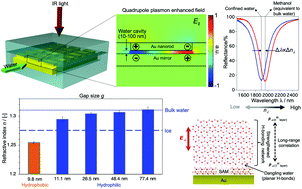Refractive index of nanoconfined water reveals its anomalous physical properties
Abstract
Despite extensive studies on the distinctive properties of water confined in a nanospace, the underlying mechanism and significance of the lengthscale involved in the confinement effects are still subjects of controversy. The dielectric constant and the refractive index in particular are key parameters in modeling and understanding nanoconfined water, yet experimental evidence is lacking. We report the measurement of the refractive indices of water in 10–100 nm spaces by exploiting the confinement of water and localized surface plasmons in a physicochemically well-defined nanocavity. The results revealed significantly low values and the scaling behavior of the out-of-plane refractive index n⊥ of confined water. They are attributed to the polarization suppression at the interfaces and the long-range correlation in electronic polarization facilitated by the strengthened H-bonding network. Using the refractive index as a sensing probe, we also observed anomalous stability of water structures over a wide range of temperature. Our measurement results provide essential feedback information for benchmarking water models and molecular interactions under nanoconfinement. This study also opens up a new methodology of using plasmon resonance in characterizing nanoconfined molecules and chemical reactions, and thus gives us fundamental insight into confinement effects.

- This article is part of the themed collection: Nanoscale Horizons 2021 Lunar New Year Collection


 Please wait while we load your content...
Please wait while we load your content...